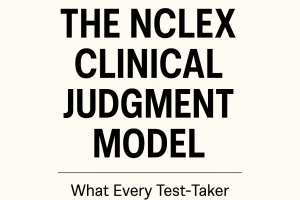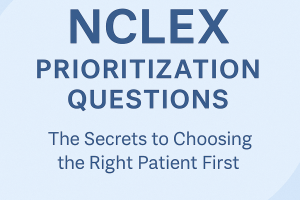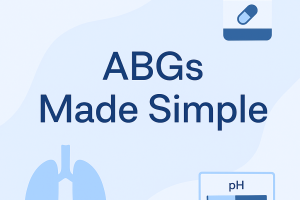UNDERSTANDING PSYCHOTROPIC MEDICATIONS FOR NCLEX

Introduction
Psychotropic medications play a vital role in managing mental health conditions, and understanding them is essential for nursing practice and NCLEX preparation. These medications affect brain function, influencing mood, behavior, and thought processes. However, their diverse categories, mechanisms, and potential side effects can make them a complex topic to master.
This blog will break down the key types of psychotropic medications, explain how they work, and highlight critical considerations for NCLEX success. By the end, you’ll feel confident navigating psychotropic pharmacology, ready to ace related exam questions, and prepared to apply this knowledge in clinical settings.
Categories of Psychotropic Medications
Psychotropic medications are classified based on the mental health conditions they treat. Below are the five main categories:
1. Antidepressants
• Purpose: Treat depression, anxiety disorders, and other mood disorders.
• Common Classes:
• Selective Serotonin Reuptake Inhibitors (SSRIs): Fluoxetine, Sertraline.
• Serotonin-Norepinephrine Reuptake Inhibitors (SNRIs): Venlafaxine, Duloxetine.
• Tricyclic Antidepressants (TCAs): Amitriptyline, Nortriptyline.
• Monoamine Oxidase Inhibitors (MAOIs): Phenelzine, Tranylcypromine.
• NCLEX Tip: Know the side effects, such as serotonin syndrome, and dietary restrictions for MAOIs (e.g., avoiding tyramine-rich foods like aged cheese and cured meats).
2. Antipsychotics
• Purpose: Manage psychotic disorders like schizophrenia, bipolar disorder, and severe mood swings.
• Types:
• First-generation (typical): Haloperidol, Chlorpromazine.
• Second-generation (atypical): Risperidone, Olanzapine, Aripiprazole.
• NCLEX Tip: Monitor for extrapyramidal symptoms (EPS) like tardive dyskinesia and neuroleptic malignant syndrome (NMS), which are potential side effects.
3. Mood Stabilizers
• Purpose: Stabilize mood swings in bipolar disorder.
• Common Examples: Lithium, Valproic Acid, Carbamazepine.
• NCLEX Tip: Lithium requires close monitoring of therapeutic levels (0.6–1.2 mEq/L) to prevent toxicity. Watch for signs like tremors, confusion, and gastrointestinal distress.
4. Anxiolytics (Anti-anxiety Medications)
• Purpose: Reduce anxiety and promote relaxation.
• Common Classes:
• Benzodiazepines: Lorazepam, Diazepam, Alprazolam.
• Non-benzodiazepines: Buspirone (long-term use).
• NCLEX Tip: Benzodiazepines can cause sedation and dependency; avoid abrupt withdrawal to prevent seizures.
5. Stimulants
• Purpose: Treat attention-deficit/hyperactivity disorder (ADHD) and narcolepsy.
• Common Examples: Methylphenidate, Amphetamine salts.
• NCLEX Tip: Watch for signs of overstimulation, such as insomnia, tachycardia, or weight loss.
Key Considerations for NCLEX Success
1. Know the Mechanism of Action
Understand how each class of medication works. For example, SSRIs increase serotonin availability in the brain, while benzodiazepines enhance GABA activity to reduce anxiety.
2. Recognize Common Side Effects
Familiarize yourself with adverse effects, such as:
• Sedation with benzodiazepines.
• Weight gain and metabolic changes with atypical antipsychotics.
• Hypertensive crisis risk with MAOIs.
3. Monitor for Toxicity and Interactions
• Lithium toxicity symptoms include confusion, ataxia, and severe nausea.
• Avoid alcohol and CNS depressants with many psychotropic medications.
4. Patient Education
Teach patients about adherence, potential side effects, and the importance of regular follow-ups for monitoring.
5. NCLEX Question Strategies
Look for keywords in the scenario, such as specific symptoms or lab values, to narrow down medication-related questions.
Practice NCLEX-Style Questions
1. A patient taking Lithium for bipolar disorder reports nausea, tremors, and confusion. What is the nurse’s priority action?
• A. Encourage the patient to eat food with their medication.
• B. Obtain a blood sample to assess Lithium levels.
• C. Withhold the next dose and administer activated charcoal.
• D. Increase the patient’s fluid intake to promote excretion.
Answer: B. Obtain a blood sample to assess Lithium levels (suspected toxicity).
2. Which dietary restriction should be taught to a patient taking Phenelzine (an MAOI)?
• A. Avoid foods rich in Vitamin K.
• B. Limit foods high in tyramine.
• C. Reduce sodium intake.
• D. Avoid potassium-rich foods.
Answer: B. Limit foods high in tyramine to prevent hypertensive crisis.
3. A patient on Risperidone experiences muscle rigidity, fever, and confusion. What is the nurse’s best intervention?
• A. Administer acetaminophen for fever.
• B. Discontinue the medication and notify the provider.
• C. Provide fluids to prevent dehydration.
• D. Encourage ambulation to reduce rigidity.
Answer: B. Discontinue the medication and notify the provider (potential neuroleptic malignant syndrome).
4. Which side effect is most associated with benzodiazepines?
• A. Insomnia.
• B. Sedation.
• C. Hypertension.
• D. Diarrhea.
Answer: B. Sedation.
5. What is the therapeutic range for Lithium?
• A. 0.5–1.0 mEq/L.
• B. 0.6–1.2 mEq/L.
• C. 1.5–2.0 mEq/L.
• D. 2.0–2.5 mEq/L.
Answer: B. 0.6–1.2 mEq/L.
Conclusion
Psychotropic medications are indispensable in managing mental health conditions, but they come with a need for careful understanding and monitoring. For NCLEX success, focus on the mechanisms, side effects, and nursing considerations for these drugs. By mastering psychotropic pharmacology, you’re not only preparing for exam questions but also ensuring safe and effective patient care in your nursing practice.
With the right preparation and strategies, you’ll feel confident tackling psychotropic medication questions and advancing your knowledge in mental health nursing.






